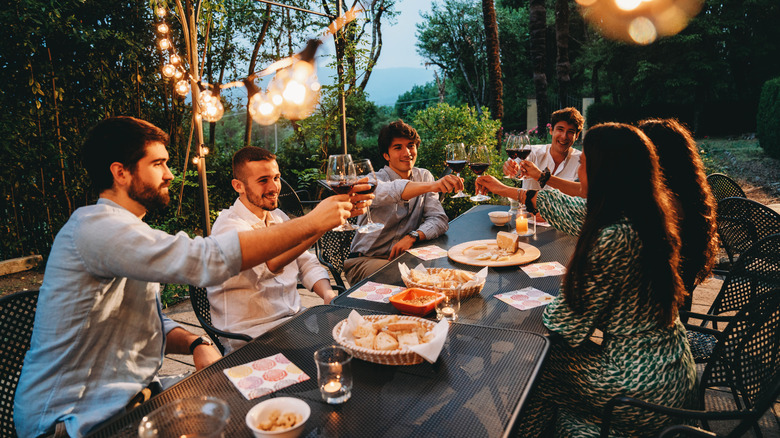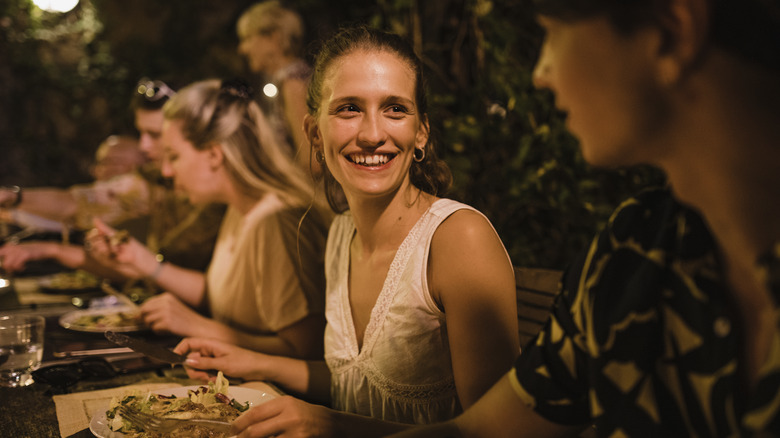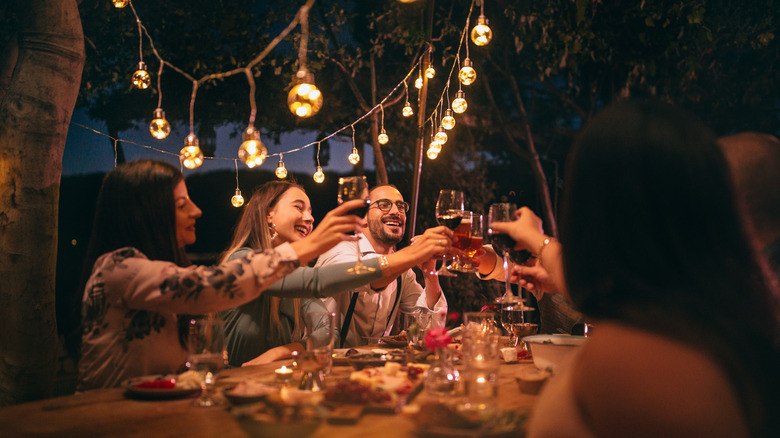Why Tourists In Italy Should Not Expect A Quick Dinner During Their Trip
Dinner at a restaurant in Italy sounds like a dream. Imagine gathering with family and friends as your big Roman holiday begins, sitting at a table full of Italian deliciousness and a few glasses of wine. However, if you're not familiar with the dining culture in Italy, you may find yourself surprised by a few things.
For starters, your server may be more relaxed than you're used to. You might have to ask for the check at the end of the meal instead of having it put on your table before you even pick up a dessert fork. Even stranger to us is the fact that restaurants may not even be open when you're used to eating dinner. Americans often dine at 6 pm or even earlier, but in Italy, dinner is eaten much later and lingered over for far longer than you may expect. There are some great reasons for this, and a longer, later, more leisurely dinner can give us time to digest and enjoy our meals in a way we might not in our everyday lives.
This is not the only meal that is different in Italy than it is in the U.S., but it's a great example of why you need to consider certain things if you want the most authentic restaurant experience while traveling. As for your Italian adventure, here's all the info you need to help plan around a wonderful part of the country's culture.
Eating dinner like an Italian
In Italy, there are various factors to consider for dining options, like avoiding restaurants located closer to landmarks and monuments, but also that it can be difficult to find a restaurant open at 6 pm as they often close between lunch and dinner. Italian dinners typically begin between 8 and 9 pm while Americans often dine much earlier. Part of the late hour is a bit of a throwback to when most people did manual labor. In many areas of Italy, it's very hot during the day and it doesn't cool down that much until the sun sets.
People still get hungry, which is why Italians often meet at a bar or cafe for what is called an aperitivo to have a glass of wine or Aperol spritz around 6 pm with nibbles like nuts and olives. Then dinner may be several courses and often lasts for hours. You may have the antipasto course (meaning before a meal — no one is "anti" pasta in Italy), which is an appetizer. Then there's il primo or the first course which is often pasta (the size of your palm) and a protein. Then il secondo which can often be a fresh salad. Then dolce is dessert or fruit. The idea is to enjoy the meal, catch up with family, and relax after a long day at work. In fact, people may linger at a restaurant until 11 pm or midnight.
Navigating Italian meal times
One of the wonderful things about traveling is getting to experience a different way of life. If you want to get into the Italian culinary experience, you should know about the other meals as well. Breakfast in Italy isn't exactly like the "complete breakfast" American TV commercials try to sell with eggs, toast, bacon, pancakes, juice, coffee, and milk. Instead, it's a cappuccino or espresso and a sweet pastry if you have anything at all — just remember to order your Italian coffee correctly, or else you'll end up with a surprise. Again, this has a weather history. You want to get as much work done as possible before it gets hot, so a quick bite in the morning is enough. Lunch is the largest meal, served between 1 pm and 2 pm (which would have been during the hottest part of the day when a break was taken).
We don't often get to slow down and eat a long, leisurely dinner in our regular lives. What a treat to get to do it during vacation. Plus, servers are paid a reasonable wage in Italy and won't shoo you out quickly to get more tips. If your day is too packed for this, hit a local grocery store for snacks to keep you going, or sandwiches and a bottle of wine for a picnic at a fountain or in a square. (You can drink anywhere in Italy, but check local laws.)


